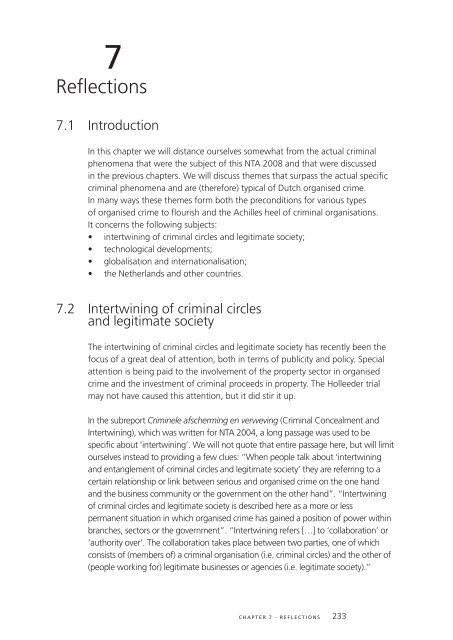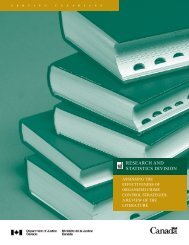- Page 1:
KLPD - IPOL Department National Thr
- Page 4 and 5:
Publisher: IPOL Department Postbus
- Page 6 and 7:
2.3.5 Crime-related factors and exp
- Page 8 and 9:
3.4.7 Conclusion 119 3.5 Crime invo
- Page 10 and 11:
5.3.1 Introduction and scope 186 5.
- Page 12 and 13:
Preface The first National Threat A
- Page 14 and 15:
Acknowledgements This National Thre
- Page 16 and 17:
phenomena - as well as on societal
- Page 18 and 19:
It should be noticed that the organ
- Page 20 and 21:
In early 2007 a Supervisory Committ
- Page 22 and 23:
1.5.3 Regional Crime Pattern Analys
- Page 24 and 25:
For environmental crime, the study
- Page 26 and 27:
A conditional threat involves crimi
- Page 28 and 29:
forces all made their contributions
- Page 30 and 31:
2 Illegal markets 2.1 Introduction
- Page 32 and 33:
with the aim of transporting large
- Page 34 and 35:
Demand In 2005 the number of ‘cur
- Page 36 and 37:
identity papers. It was impossible
- Page 38 and 39:
use currently occurring in various
- Page 40 and 41:
An important indicator of heroin pr
- Page 42 and 43:
2.3.3 Criminal organisations Three
- Page 44 and 45:
without being noticed. The harm tha
- Page 46 and 47:
Criminals often look for a remote l
- Page 48 and 49:
other than BMK and PMK are increasi
- Page 50 and 51:
LSD (lysergic acid diethylamide) is
- Page 52 and 53:
From the source country onwards, th
- Page 54 and 55:
People can also be the victims of i
- Page 56 and 57:
Other chemicals will probably be ob
- Page 58 and 59:
the expectation that organised crim
- Page 60 and 61:
Figure 2 Number of nurseries disman
- Page 62 and 63:
which is just over 360,000 people.
- Page 64 and 65:
A strikingly high number of crimina
- Page 66 and 67:
mortgage. Various types of fraud ar
- Page 68 and 69:
and Romanians who already work in t
- Page 70 and 71:
offences under Section 273f of the
- Page 72 and 73:
2.6.3 Scale Exploitation in prostit
- Page 74 and 75:
2.6.6 Crime-related factors and exp
- Page 76 and 77:
2.7 Illegal immigrant smuggling 30
- Page 78 and 79:
who have been in the Netherlands il
- Page 80 and 81:
were registered as being suspected
- Page 82 and 83:
It is not known whether the positio
- Page 84 and 85:
the weapons are stashed at a safe a
- Page 86 and 87:
limited scale of detection of illeg
- Page 88 and 89:
The commercial production of images
- Page 90 and 91:
in isolation. According to the IPOL
- Page 92 and 93:
continued existence of both the pro
- Page 94 and 95:
2.10.3 Scale In the Netherlands mos
- Page 96 and 97:
developments relating to counterfei
- Page 98 and 99:
3.2 The public purse: VAT fraud, ex
- Page 100 and 101:
a separate legal entity takes care
- Page 102 and 103:
Table 6 Misuse of companies in 2000
- Page 104 and 105:
Chinese Dutch nationals are reporte
- Page 106 and 107:
have created more opportunities wit
- Page 108 and 109:
Investment fraud is the general nam
- Page 110 and 111:
Almost all contacts in advance fee
- Page 112 and 113:
The structure of a boiler room is d
- Page 114 and 115:
caught will increase. Fraudsters su
- Page 116 and 117:
a role, namely the fact that superv
- Page 118 and 119:
special investigation services. The
- Page 120 and 121:
competition. In the past this has r
- Page 122 and 123:
• electronic and electrical appli
- Page 124 and 125:
Any violation of the EU Regulation
- Page 126 and 127:
level. Out of a selection of more t
- Page 128 and 129:
those used for scrap vehicles. A lo
- Page 130 and 131:
As well as being numerous and compl
- Page 132 and 133:
consequences of the exporting of th
- Page 134 and 135:
In recent years, the integration ph
- Page 136 and 137:
Criminals invest in property togeth
- Page 138 and 139:
Undermining of the rule of law and
- Page 140 and 141:
Professionals’ right of non-discl
- Page 142 and 143:
3.6.7 Conclusion The investment of
- Page 144 and 145:
Factors related to property crime F
- Page 146 and 147:
The relative poverty in many Easter
- Page 148 and 149:
• An elderly lady is working in h
- Page 150 and 151:
connections between offences cannot
- Page 152 and 153:
4.3 Shoplifting 4.3.1 Introduction
- Page 154 and 155:
4.3.7 Conclusion As a result of sho
- Page 156 and 157:
audio and video equipment and build
- Page 158 and 159:
Mainly native Dutch offender groups
- Page 160 and 161:
However, there are also factors tha
- Page 162 and 163:
According to the National Vehicle C
- Page 164 and 165:
Table 8 Development of recorded car
- Page 166 and 167:
4.5.5 Consequences for Dutch societ
- Page 168 and 169:
Robberies can be described as the r
- Page 170 and 171:
Ram raiding Ram raids have been rec
- Page 172 and 173:
damage to buildings, etc. In one ca
- Page 174 and 175:
‘Organised, supraregional ram rai
- Page 176 and 177:
4.7.5 Consequences for Dutch societ
- Page 178 and 179:
4.8.2 General context The handling
- Page 180 and 181:
4.8.5 Consequences for Dutch societ
- Page 182 and 183:
5.2.2 Corruption of public servants
- Page 184 and 185: Scale For years the Netherlands has
- Page 186 and 187: make contact with one another. By d
- Page 188 and 189: In cases of investment fraud, poten
- Page 190 and 191: 1. Enforcement of behaviour In case
- Page 192 and 193: The use of violence within criminal
- Page 194 and 195: In addition, the financial damage t
- Page 196 and 197: However, they were found guilty of
- Page 198 and 199: takes them to a counterfeit website
- Page 200 and 201: equired to defraud Internet users c
- Page 202 and 203: customers. Customers must be on the
- Page 204 and 205: Quite often, organised crime does n
- Page 206 and 207: for criminal purposes, it is likely
- Page 208 and 209: 5.7 Counterstrategies 5.7.1 Introdu
- Page 210 and 211: potential witnesses refused (or wer
- Page 212 and 213: eceive protection, as there is alwa
- Page 214 and 215: 5.8.2 General context Forgery of do
- Page 216 and 217: Chamber of Commerce and the municip
- Page 218 and 219: 5.8.6 Crime-related factors and exp
- Page 220 and 221: 6.2 Criminal caravan camp residents
- Page 222 and 223: Nederweed In the subreport on canna
- Page 224 and 225: Roma have been reported for committ
- Page 226 and 227: 6.4 Criminal liaisons British crimi
- Page 228 and 229: The use of solvents to extract coca
- Page 230 and 231: on the Internet and growing equipme
- Page 232 and 233: egularly found in suspicious circum
- Page 236 and 237: Unlike in 2004, the intertwining of
- Page 238 and 239: organisations have access to one or
- Page 240 and 241: at Schiphol Airport and lorry drive
- Page 242 and 243: Whenever illegal markets such as th
- Page 244 and 245: Appendix 1 Project structure Projec
- Page 246 and 247: E.R. Kleemans Senior Researcher Res
- Page 248 and 249: F. van den Heuvell Analysis Special
- Page 250 and 251: J. ’t Lam Strategic Analyst Natio
- Page 252 and 253: Appendix 2 Overview of qualificatio
- Page 259: Netherlands Police Agency








